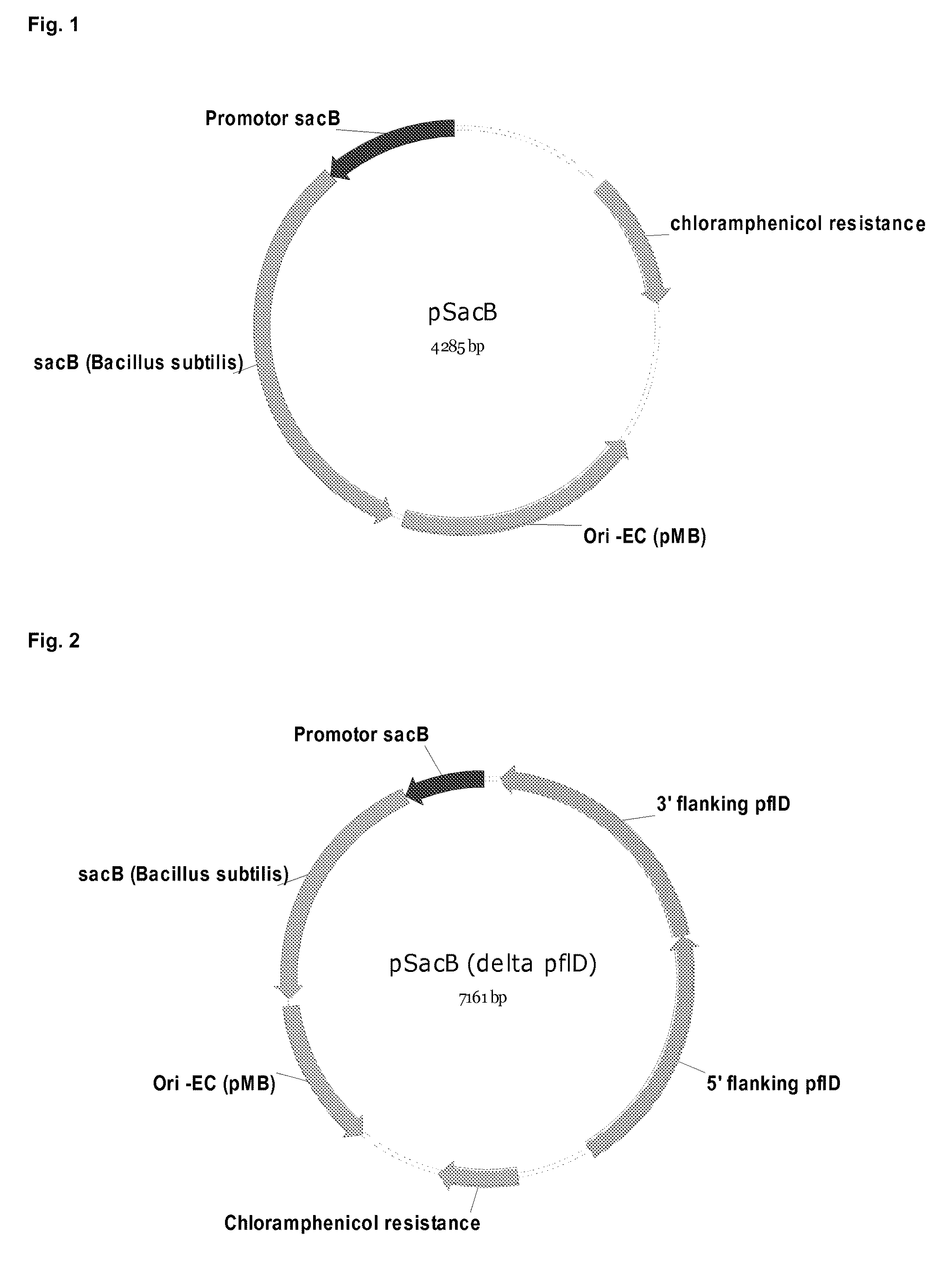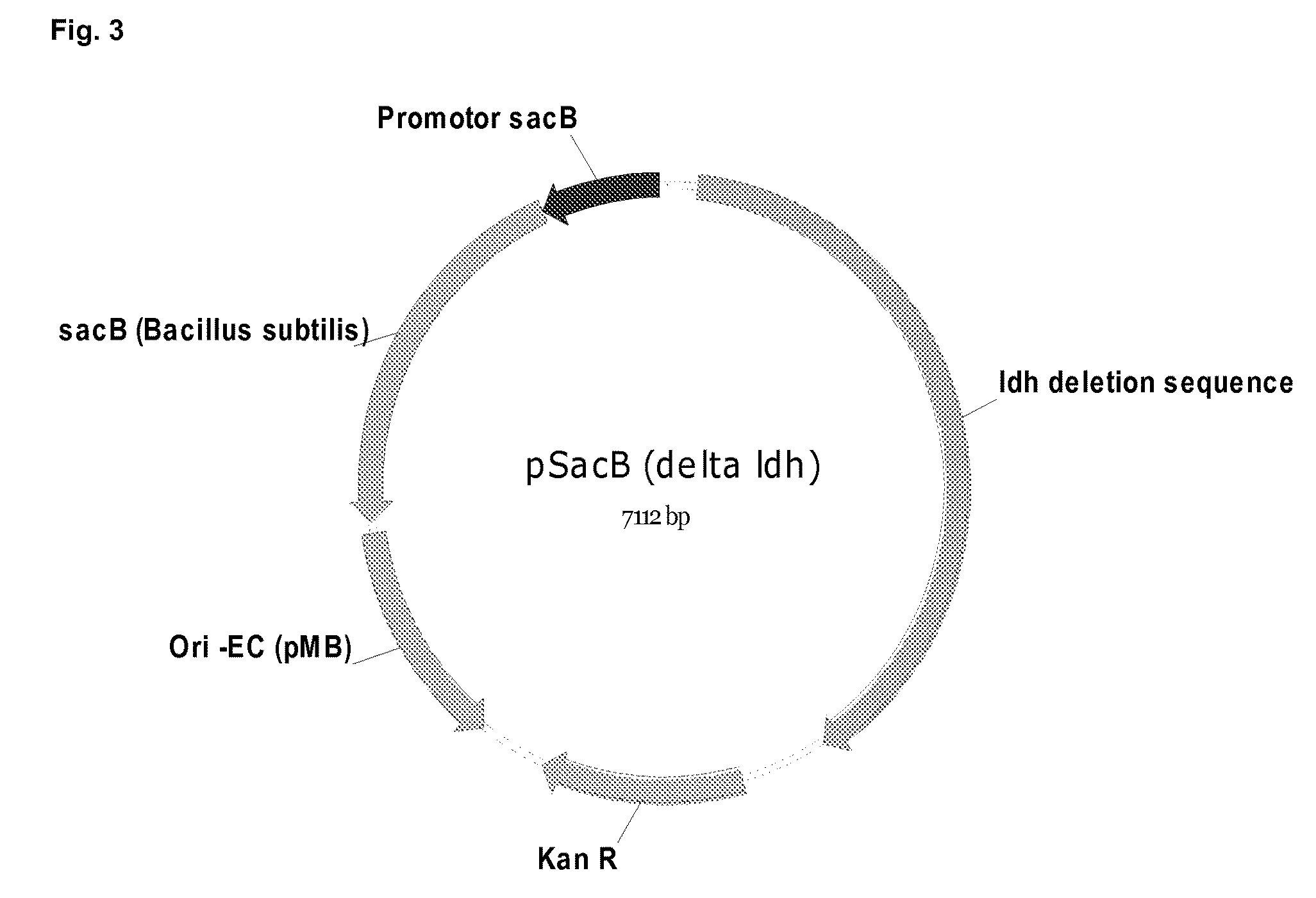Microbial succinic acid producers and purification of succinic acid
a technology of succinic acid and producers, applied in the direction of transferases, bulk chemical production, bacteria based processes, etc., can solve the problems of slow carbohydrate utilization, slow growth, inability to ferment a saccharide to completion under anaerobic conditions, etc., and achieve the effect of improving the technical behavior of sa fermentation
- Summary
- Abstract
- Description
- Claims
- Application Information
AI Technical Summary
Benefits of technology
Problems solved by technology
Method used
Image
Examples
example 1
General Method for the Transformation of DD1
[0172]
TABLE 1Nomenclature of the DD1 wildtype andmutants referred to in the examples.StrainDescriptionLU13843Wildtype DD1 (deposit DSM18541)LU15348DD1 Δ pflLU15050DD1 Δ ldhLU15224DD1 Δ pfl Δ ldh
[0173]Pasteurella strain LU13843 (wildtype DD1) was transformed with DNA by electroporation using the following protocol:
[0174]For preparing a pre-culture LU 13843 was inoculated from a freshly grown BHI-Agar plate into 40 ml BHI (brain heart infusion, Difco) in 100 ml shake flask. Incubation was performed over night at 30° C.; 200 rpm.
[0175]For preparing the main-culture 50 ml BHI were placed in a 100 ml shake flask and inoculated to a final OD (610 nm) of 0.4 with the preculture. Incubation was performed for approximately 1.5 h at 30° C., 200 rpm. The cells were harvested at an OD of approximately 1.3, pellet were washed once with 10% cold glycerol at 4° C. and resuspended in 1.7 ml 10% glycerol (4° C.).
[0176]100 μl of competent cells were the mix...
example 2
Generation of Deletion Constructs
[0178]Mutation / deletion plasmids were constructed based on the vector pSacB (SEQ ID NO 3). FIG. 1 shows a schematic map of plasmid pSacB. 5′- and 3′-flanking regions of the chromosomal fragment, which should be deleted were amplified by PCR from chromosomal DNA of LU 13843 and introduced into said vector using standard techniques. Normally, at least 80% of the ORF were targeted for a deletion. In such a way, the deletion plasmids for the pyruvate-formate-lyase pfl, pSacB (Δ pfl) (SEQ ID NO 4), and the lactate dehydrogenase IdhA, pSacB (Δ IdhA) (SEQ ID NO 5) were constructed. FIGS. 2 and 3 show schematic maps of plasmid pSacB (Δ pfl) and pSacB (Δ IdhA).
[0179]In the plasmid sequence of pSacB (SEQ ID NO:3) the sacB gene is contained from bases 5169-6590. The chloramphenicol gene is contained from base 526-984. The sacB promotor is contained from bases 3802-4264. The chloramphenicol gene is contained from base 526-984. The origin of replication for E. co...
example 3
Generation of Improved Succinate Producing Strains
[0182]a) LU 13843 was transformed as described above with the pSacB (A pfl) and “Campbelled in” to yield a “Campbell in” strain. Transformation and integration into the genome of LU 13843 was confirmed by PCR yielding bands for the integrational event of the plasmid into the genome of LU 13843.
[0183]The “Campbell in” strain was then “Campbelled out” using agar plates containing sucrose as a counter selection medium, selecting for the loss (of function) of the sacB gene. Therefore, the “Campbell in” strains were incubated in 25-35 ml of non selective medium (BHI containing no antibiotic) at 37° C., 220 rpm over night. The overnight culture was then streaked onto freshly prepared BHI containing sucrose plates (10%, no antibiotics) and incubated overnight at 37° C. (“first sucrose transfer”). Single colony obtained from first transfer were again streaked onto freshly prepared BHI containing sucrose plates (10%) and incubated overnight a...
PUM
| Property | Measurement | Unit |
|---|---|---|
| concentrations | aaaaa | aaaaa |
| concentrations | aaaaa | aaaaa |
| concentrations | aaaaa | aaaaa |
Abstract
Description
Claims
Application Information
 Login to View More
Login to View More - R&D
- Intellectual Property
- Life Sciences
- Materials
- Tech Scout
- Unparalleled Data Quality
- Higher Quality Content
- 60% Fewer Hallucinations
Browse by: Latest US Patents, China's latest patents, Technical Efficacy Thesaurus, Application Domain, Technology Topic, Popular Technical Reports.
© 2025 PatSnap. All rights reserved.Legal|Privacy policy|Modern Slavery Act Transparency Statement|Sitemap|About US| Contact US: help@patsnap.com


